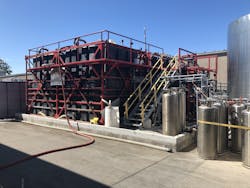Water & Wastewater Treatment in the Food Industry
About the author:
Robert McIlvaine is president of McIlvaine Co. McIlvaine can be reached at [email protected] or 847.784.0012.
In food processing plants, water use starts with conditioning raw materials such as soaking, cleaning, blanching and chilling. It continues with cooling, sanitizing, steam generation for sterilization, power and process heating, and, finally, direct “in-process” use. The water classification categories used in the food and beverage industries are general purpose, process, cooling and boiler feed.
Sanitary conditions always have been a concern for food products created in the manufacturing process. Disinfection through chlorination has been the quickest means of disinfecting wastewater, which has come under criticism due to chlorination byproducts and toxicity concerns that residual chlorine poses to aquatic life. The two principal means of disinfecting wastewater without using chlorination are ozone disinfection or ultraviolet (UV) disinfection. Ozonation works on the same principles as chlorination, but leaves no residual in the treated wastewater and does not produce the magnitude of disinfection byproducts that chlorination does.
General Purpose Water
General purpose water includes all of the water used in washing and sanitizing raw materials, processing equipment, plant facility and ancillary equipment. It is used in the largest amounts and it should be potable, clear, colorless and free of contaminants that affect taste or odor. In-plant chlorination usually is the only treatment required.
The main advantage of in-plant chlorination of general purpose water is microbe reduction on raw materials, prepared products and equipment surfaces in the plant. There is no action as important to food and beverage processing as control of microorganisms.
Process Water
Water used for cooking or added directly to the product must be potable and of sufficient quality so as not to degrade product quality. This includes being free of dissolved minerals that make water excessively hard or affect taste.
Most of the product in beverage production consists of process water, so treatment to achieve taste objectives is especially important. Often, treatment beyond that required to meet safe drinking water standards is essential for consistent quality.
Treatment processes used in bottled water often include softening, reverse osmosis and deionization. Many other beverages require similar treatment.
Hard water contains minerals that can affect the texture of the raw materials to be processed; such as certain vegetables. Iron, manganese or sulfate can have an undesirable affect on the taste of the product.
The methods used for terminal disinfection include chemical, thermal, radiation, and ultrasonic treatment or cell disruption.
Cooling Water
Cooling water not in contact with food products or sealed containers does not have to be potable or meet the requirements of process water, as the removal of staining minerals and odors is not as important. However, preventing the accumulation of scale in pipe and equipment is important, especially when cooling water is recycled.
The most efficient processing systems include recycling circuits to reduce cooling water waste, thus reducing processing costs. Potable water, even from public supplies, often has to receive additional treatment such as softening to avoid scale and deposits to be suitable for cooling.
Boiler Feedwater
Boiler feedwater requires the removal of hardness. This may be the only treatment process applied to the water; if this water is not in contact with food, it does not have to be potable. Boiler feedwater for high-pressure boilers requires demineralization or the removal of all dissolved solids. Almost all potable water must have minerals removed through additional treatment to be suitable for boiler feed. Not only can microorganisms produce color and odor in water, but, if they are introduced into the production process, they can contaminate the equipment and finished product. Process contamination could damage and spoil foodstuffs. If pathogenic bacteria is introduced in the contamination, food poisoning could occur.
Wastewater
Food wastewater contains residues that deplete the oxygen in receiving streams.
Chemical oxygen demand (COD) and biochemical oxygen demand (BOD) are common measurements used to determine water quality. They measure the strength of the waste stream by measuring the oxygen required to stabilize the wastes. COD and BOD are important to the food processing industry because they can be used to indicate lost product and wasteful practices. High BOD and COD levels indicate increased amounts of product lost to the waste stream. Measurements at various process locations can help locate sources of waste.
At any point in a particular food processing operation, the relationship between BOD and COD is fairly consistent. However, the ratios of these two measures vary widely depending on the type of product.
Download: Here
